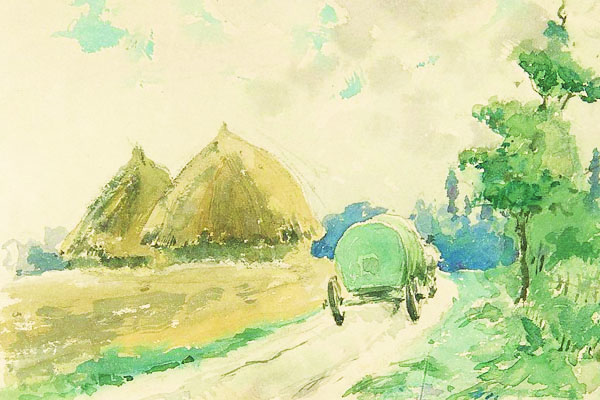I read a diary from the 13th century, and this is what I found
Image by Zacharie Astruc “Landscape with Wagon and Haystacks” ca. 1869-70 from The Metropolitan Museum Open Access Program.
Of all things to do during lockdown, falling down a rabbit hole of 13th century travel journals was not high on my list. I couldn’t pinpoint when it happened if you asked me. I suppose in my stir-crazy haze my mind needed the openness of the Silk Road, though for many that openness was a danger. The contrast of sitting in my house for days and weeks on end to months if not years of open road for travelers hundreds of years before my birth was an offer too enticing to refuse. I knew all too well what my life was like — what was theirs?
My first instinct was to search for documentaries or articles online about the Silk Road. Everything I found outlined major events and key players in the history of the Silk Road, but none of them showed the mundane day-to-day things people experienced. I don’t live my life thinking in terms of the next great event, I live it day-by-day. I wanted to read about theirs in the same way.
Thankfully, I had some experience researching obscure history. In the fall of this year, I worked at a local museum and had access to all their research materials. I read about English settlers trading with the Delaware, immigrating to the U.S., and waiting out the Revolutionary War on cold, long nights. These are the in-between moments. There is no great battle, no intrigue, no scandal, just people complaining about a hole in their sock, writing down what they ate for breakfast, how long it took them to cross a valley and what they saw while they did it.
I knew there had to be similar journals for travelers on the Silk Road. Marco Polo’s account is the most well known but there were bound to be others. And there were. I did a quick search online and found a dozen names of people who traveled and wrote about it. My first was William of Rubruck, a Flemish Franciscan monk.
I was able to find his account online for free with translations and annotations to help me understand. He didn’t write it in English, which means it doesn’t read like Shakespeare. It reads, for the most part, like any contemporary work. He starts his journal when he is advised to take oxen so he doesn’t have to unload his cart everyday. He regrets this, explaining, “Then I accepted their advice, unfortunately, however, for I was two months on the way to Sartach, which I might have traveled in one had I gone with horses.”
It’s worth noting, here, that Rubruck and other European travelers like him had little to no prior contact with the outside world. They travelled through Europe and Rubruck specifically made it as far as Palestine, but this journal took him farther east. I don’t claim these accounts to be entirely factual and free of bias, but they offer a perspective into the past rarely seen. Rubruck and the people he meets are familiar in that they complain, enjoy parties, are hungry, are tired, and are opinionated. They are human and not the somber characters in shows like “Game of Thrones” or “The Crown.”
Many of the books have introductory notes that explain how shaky the credibility of the text is. It turns out people in the 12th, 13th and 14th centuries were as prone to fault and laziness as we are. They didn’t factcheck the accounts, and they didn’t bother to verify their translations. People wanted to read about far off places so they printed the books. There wasn’t much else to it. Authors at this time had no copyright over their work, so they gained next to nothing for the copies printed and distributed.
There was also little value to the stories other than entertainment. People discarded and forgot the tales as easily as we might forget a funny Tweet or Youtube video, never to be found or tracked down again. Most, if not all, of these travelogues are so old and have such low commercial value that they are free. Even Marco Polo’s accounts are available online at no cost.
When Rubruck is found by a nomadic group in modern day Turkey, they surround him and ask “whether we had ever been among them before. Having answered that we had not, they began to beg most impudently for some of our provisions. We gave them some of the biscuit and wine that we had brought with us from the city, and when they had drunk one flagon they asked for another, saying that a man enters not a house with one foot only.”
He spends about two months with them, eating, talking, and observing their culture. He details the houses they live in, the clothes they were, the food they eat, and how they interact with each other and strangers. They are mostly curious of one another, though still distant and distrusting like anyone would be of someone passing through. But they are not hostile, which I think so many movies and shows try to portray people from the past to be.
It’s not my goal for you to read them. They are, after all, hundreds of years old written by privileged men who misrepresented and judged the people they met on their travels. Read them, if you do, with a hefty amount of salt. But sometimes it’s nice to know that there are lives beyond ours. Fantastical stories don’t have to exist only in fantasy or fiction. Having lived in lockdown for a whole year now, it’s nice to read about people who traveled for miles and miles in the open air. It took three years for Rubruck to return home. In that time, he saw more than most people see in their lives. If he could do it in the 13th century, then no matter how bad it gets, there are always things to look forward to.

























